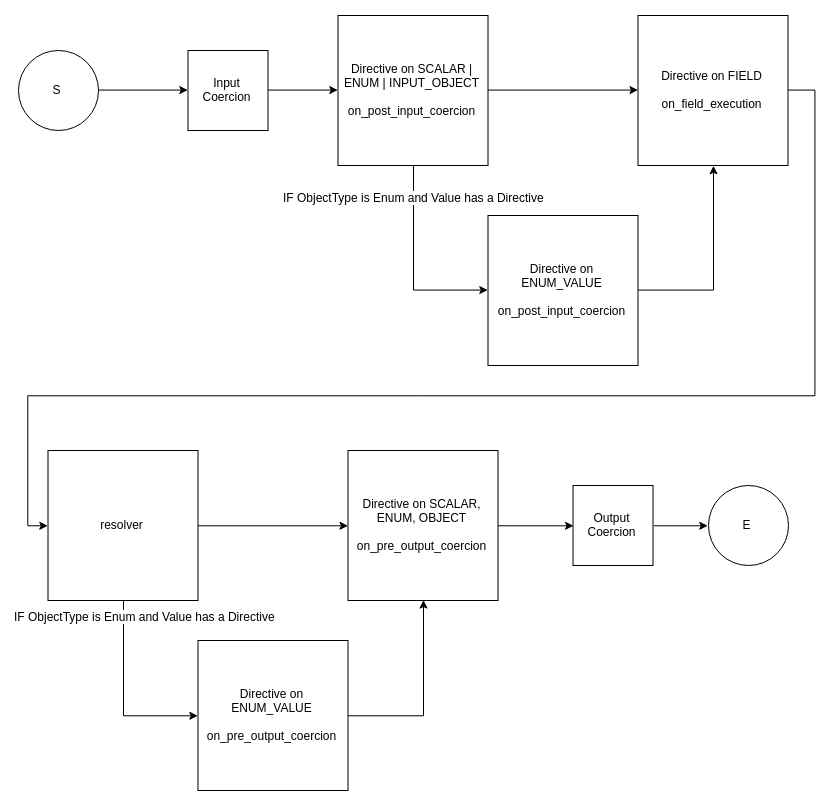Directive
Tartiflette bases most of its extensibility on directives. A directive will allow you to execute a behavior at different stages:
on_argument_execution: allows you to wrap the argument execution. (e.g. access rights, validate the input format...)on_post_input_coercion: allows you to hook the execution flow right after an input value/variable has beed coerced (appears in version0.10.0)on_field_execution: allows you to wrap the field execution. (e.g. resolve the field remotly, apply a specific rate limit on a field...)on_pre_output_coercion: allows you to mutate the result of the resolved value of a field before returning it (appears in version0.10.0)on_introspection: during an introspection query, allows you to wrap the schema fields to add metadata to fields or even to remove objects (e.g. dynamic introspection based on access rights)
How to declare a new directive?
directive @myDirective(
name: String = "Chuck"
) on FIELD_DEFINITION
type Query {
hello: String @myDirective(name: "Norris")
}
from typing import Any, Callable, Dict, Optional, Union
from tartiflette import Directive
@Directive("myDirective")
class MyDirective:
async def on_argument_execution(
self,
directive_args: Dict[str, Any],
next_directive: Callable,
parent_node: Union["FieldNode", "DirectiveNode"],
argument_node: "ArgumentNode",
value: Any,
ctx: Optional[Any],
) -> Any:
######################
# Add your code here #
######################
return await next_directive(parent_node, argument_node, value, ctx)
async def on_post_input_coercion(
self,
directive_args: Dict[str, Any],
next_directive: Callable,
parent_node: Union["VariableDefinitionNode", "InputValueDefinitionNode"],
value: Any,
ctx: Optional[Any],
) -> Any:
######################
# Add your code here #
######################
return await next_directive(parent_node, value, ctx)
async def on_field_execution(
self,
directive_args: Dict[str, Any],
next_resolver: Callable,
parent: Optional[Any],
args: Dict[str, Any],
ctx: Optional[Any],
info: "ResolveInfo",
) -> Any:
######################
# Add your code here #
######################
return await next_resolver(parent, args, ctx, info)
async def on_pre_output_coercion(
self,
directive_args: Dict[str, Any],
next_directive: Callable,
value: Any,
ctx: Optional[Any],
info: "ResolveInfo",
) -> Any:
######################
# Add your code here #
######################
return await next_directive(value, ctx, info)
async def on_introspection(
self,
directive_args: Dict[str, Any],
next_directive: Callable,
introspected_element: Any,
ctx: Optional[Any],
info: "ResolveInfo",
) -> Any:
######################
# Add your code here #
######################
return await next_directive(introspected_element, ctx, info)
Execution flow
Warning: This is valid since
0.10.0.
Directive hook execution flow is like:

Example
directive @directiveField on FIELD
directive @directiveScalar on SCALAR
directive @directiveEnum on ENUM
directive @directiveEnumValue on ENUM_VALUE
directive @directiveObject on OBJECT
directive @directiveInputObject on INPUT_OBJECT
directive @directiveArgument on ARGUMENT
scalar aScalar @directiveScalar
enum anEnum @directiveEnum {
ONE @directiveEnumValue
TWO
}
input anInputObject @directiveInputObject {
anInputField: aScalar
}
type aType @directiveObject {
aField: aScalar @directiveField
anEnumField: anEnum @directiveField
}
type Query {
field1: aType
field2(anArgument: anInputObject @directiveArgument): aType
field3: anEnum
}
with Resolvers as:
@Resolver("Query.field1")
async def resolve_query_field1(parent, args, ctx, info):
return {"aField": "aValue", "anEnumField":"ONE"}
@Resolver("Query.field2")
async def resolve_query_field2(parent, args, ctx, info):
return {"aField": "aValue", "anEnumField":"TWO"}
@Resolver("Query.field3")
async def resolve_query_field3(parent, args, ctx, info):
return "TWO"
Query 1
query aQuery {
field1 {
aField
anEnumField
}
}
The resolution of Query.field1 will ran:
Query.field1resolveron_pre_output_coercionof directivedirectiveObjectof typeaTypeoutput_coercerforObjectType
Then the resolution of aType.aField will ran (parrallely ran with aType.anEnumField):
on_field_executionof directivedirectiveFieldonaType.aFieldaType.aFieldresolveron_pre_output_coercionof directivedirectiveScalaronaScalaroutput_coercerof the scalaraScalar
The resolution of aType.anEnumField will ran (parrallely ran with aType.aField):
on_field_executionof directivedirectiveFieldonaType.anEnumFieldaType.anEnumFieldresolveron_pre_output_coercionof directivedirectiveEnumValuecauseONEhas a directiveon_pre_output_coercionof directivedirectiveEnumof enumanEnumoutput_coercerfor enum
Query 2
query aQuery {
field2(anArgument: {anInputField: 3}) {
aField
anEnumField
}
}
The resolution of Query.field2 will ran:
input_coercerforInputObjectTypeinput_coercerfor argumentanInputFieldof typeaScalaron_post_input_coercionof directivedirectiveScalarof scalaraScalaron_post_input_coercionof directivedirectiveInputObjectof typeanInputTypeon_argument_executionof directivedirectiveArgumentfor argumentanArgumentQuery.field2resolveron_pre_output_coercionof directivedirectiveObjectof typeaTypeoutput_coercerforObjectType
Then the resolution of aType.aField will ran (parrallely ran with aType.anEnumField):
on_field_executionof directivedirectiveFieldonaType.aFieldaType.aFieldresolveron_pre_output_coercionof directivedirectiveScalaronaScalaroutput_coercerof the scalaraScalar
The resolution of aType.anEnumField will ran (parrallely ran with aType.aField):
on_field_executionof directivedirectiveFieldonaType.anEnumFieldaType.anEnumFieldresolver (methodatype_anenumfield_resolverreturned "ONE")on_pre_output_coercionof directivedirectiveEnumValuecauseONEhas a directiveon_pre_output_coercionof directivedirectiveEnumof enumanEnumoutput_coercerfor enum
Query 3
query aQuery {
field3
}
The resolution of Query.field3 will ran:
Query.field3resolveron_pre_output_coercionof directivedirectiveEnumof enumanEnumoutput_coercerforEnumType
